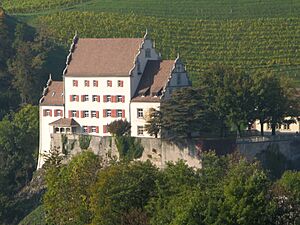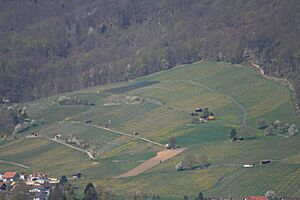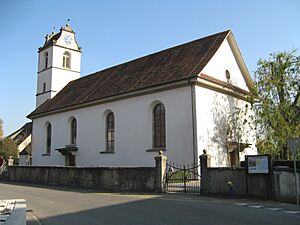Schinznach facts for kids
Quick facts for kids
Schinznach
|
||
|---|---|---|
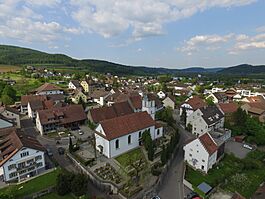 |
||
|
||
| Country | Switzerland | |
| Canton | Aargau | |
| District | Brugg | |
| Area | ||
| • Total | 12.24 km2 (4.73 sq mi) | |
| Elevation | 383 m (1,257 ft) | |
| Population
(Dec 2020 )
|
||
| • Total | 2,319 | |
| • Density | 189.46/km2 (490.70/sq mi) | |
| Postal code |
5107-08
|
|
| Surrounded by | Holderbank, Linn, Oberflachs, Schinznach-Bad, Thalheim, Veltheim, Villnachern, Zeihen | |
Schinznach is a town, also called a municipality, located in Switzerland. It's part of the Brugg district in the canton of Aargau. On January 1, 2014, two smaller towns, Oberflachs and Schinznach-Dorf, joined together to create the new municipality of Schinznach.
A Look Back at Schinznach's Past
The Story of Oberflachs
People have found old Roman bricks and coins here, showing that people lived in this area a long time ago. The first time Oberflachs was officially written about was in 1342.
During the Middle Ages, a place called Kasteln Castle was very important. It ruled over the village and had the power to make decisions in local legal cases, known as the low court. At first, bigger legal cases (the high court) were handled by a nearby area called Schenkenberg. But in 1460, the city of Bern took over the high court. By 1607, Oberflachs was almost like its own small town. In 1732, Bern bought Kasteln Castle and took full control of the village.
In the 1700s, Oberflachs was a very poor area. Most people made a living by growing grain and grapes for wine. But in 1850, a plant disease called phylloxera badly damaged the grapevines, causing wine production to stop. Because of this poverty, many people had to move to other countries. Eventually, ways were found to treat the grapevines, and they started to grow again. By 1990, vineyards covered about 22 hectares (about 54 acres) in the town.
By 1960, more people were traveling to work outside Oberflachs than those who worked within the town. However, the number of people living in Oberflachs kept growing. In the 1970s, new neighborhoods were built. In 2005, farming still provided jobs for 28% of the community. In 2009, there was a plan for Oberflachs to join with four other towns, but the people of Veltheim voted against it, so the merger didn't happen.
The Story of Schinznach-Dorf
Schinznach-Dorf was first mentioned in 1189. However, people lived in this area even earlier, during the Stone Age. Scientists have found signs of a shelter from the Middle Stone Age, a village from the New Stone Age, and two Roman country houses, showing that people have lived here for a very long time.
The city of Bern gained the right to handle local legal cases (the low court) in the village in 1460. Over time, the villagers slowly gained more rights from their local ruler, called a Zwingherr. By 1547, they had their own town charter, which was a set of rules for how the town would be run. A village school opened in the 1600s.
In 1654, a special hot spring with sulfur was found near the village. A town called Schinznach-Bad grew up around this spring. Even after the spring disappeared in 1670 and then reappeared on the other side of the Aare river in 1691, the town kept its name.
The local economy mostly depended on vineyards, which are farms that grow grapes for wine. When grape production dropped in the 1870s because of diseases, many people had to move away. Today, vineyards cover about 31 hectares (about 76 acres), which is much less than the 81 hectares (about 200 acres) they covered in 1857.
In 1875, a train station was built in the village. But the train line didn't do very well, and the station closed in 1993. In the 1960s, the number of people living in the village grew, and several new housing areas were built.
The village church, named Saint George, was first mentioned in 1227. In 1650, a special chapel for funerals was built next to the church for the rich von Erlach family. The old church building was replaced with a new one in 1779.
Geography and Area
The towns that now make up Schinznach have a total combined area of about 12.23 square kilometers (about 4.72 square miles).
Population Information
As of December 31, 2022, the total population of Schinznach is 2,423 people.
How the Population Has Changed Over Time
This chart shows how the population of Schinznach-Dorf and Oberflachs changed over many years before they merged:
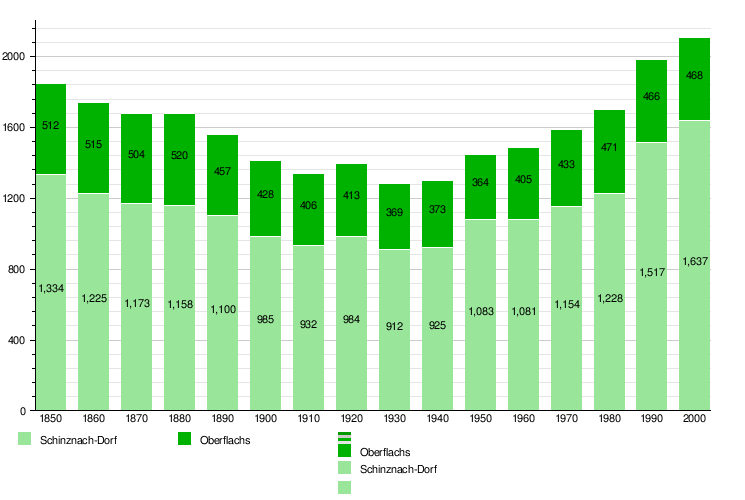
Important Heritage Sites
The Reformed Church and the Erlach Chapel in Schinznach are very important historical places. They are listed as a Swiss heritage site of national significance. This means they are protected because of their special history and culture.
Both Schinznach-Dorf and Oberflachs are also part of the Inventory of Swiss Heritage Sites. This list includes places that are important for Switzerland's history and culture.
See also
 In Spanish: Schinznach para niños
In Spanish: Schinznach para niños





